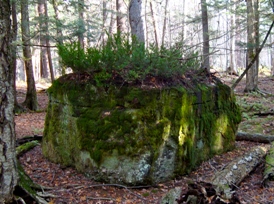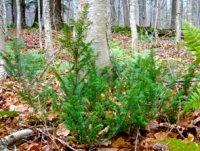These "berries" are edible but the seed is highly toxic. Eating the berries even with the seeds removed may be a risky venture and is not advised. Birds' digestive systems do not break down the seed coats on the seeds so they are unharmed by eating the berries but the human digestive track begins to break down the seeds and toxins are released. All other parts of the plant are toxic and horses and cows have been known to drop dead after eating the leaves.
Description: Canada Yew, also called American Yew and Ground Hemlock, is very similar in appearance to English Yew but is shorter (less than 2 meters tall) at maturity, less dense, and has a spreading often almost prostrate habit. One shrub may form a small colony over time and many shrubs can form a large colony. The fruit is a red aril, typical of other yews.
Distribution, Habitat, and Cultivation: Canada Yew is found throughout Wisconsin but because of the loss of old growth forest and browsing by a very large deer population it is now in decline and listed as a species of special concern. Canada Yew is also found in eastern Minnesota, northern Michigan, across the northeast states and southeast Canada. T. canadensis is most often found growing in moist soil in partial to full shade in mixed conifer hardwood forests, in ravines, and along slopes near rivers and lake shores. In the southern portion of it's range it is more common on north facing slopes indicating that it prefers to stay cool. Due to deer browsing it is now primarily seen growing in places inaccessable to deer such as on cliffs and steep slopes. Little information is available about cultivating Canada Yew in the home landscape but it seems that it would make an attractive addition to a partially to fully shaded yard or perhaps be able to handle full sun in a spot where the soil stays cool and moist. Urban yards and forests are great places to try this now rare plant as there is less pressure from deer grazing. We have experimentally planted a few young Canada Yews in Riverside Park.
Wildlife: Birds eat the berries of Canada Yew and pass the seeds without damaging them which keeps the birds safe from the toxins and aids the yew in seed dirspersal. Because they are evergreen, thickets of canada yew provide year round cover for birds and other small animals.
 Cultural Value: Due to their extreme longevity and toxicity yews came to symbolize life and death and were considered sacred in many traditional European cultures. Yews contain a variety of compounds called taxanes which have been the subject of much research for cancer treatments. The fresh growth of Canada Yew can be sustainably collected every five years to obtain these compounds and it is often harvested in the wild or in cultivation in much of it's range. Here in Wisconsin English Yew (Taxus baccata), Japanese Yew (Taxus cuspidata) and their hybrids and cultivars are popular in foundation plantings around homes and commercial buildings. Yews are evergreen, hardy, and long lived, and are often trimmed into boxy hedges and conical trees by those who prefer a geometric and formal look. The landscaping and horticultural establishment have not adopted and promoted the planting of Canada Yew (perhaps because of its slightly less dense, sprawling habit) but there's no reason we can't.
Cultural Value: Due to their extreme longevity and toxicity yews came to symbolize life and death and were considered sacred in many traditional European cultures. Yews contain a variety of compounds called taxanes which have been the subject of much research for cancer treatments. The fresh growth of Canada Yew can be sustainably collected every five years to obtain these compounds and it is often harvested in the wild or in cultivation in much of it's range. Here in Wisconsin English Yew (Taxus baccata), Japanese Yew (Taxus cuspidata) and their hybrids and cultivars are popular in foundation plantings around homes and commercial buildings. Yews are evergreen, hardy, and long lived, and are often trimmed into boxy hedges and conical trees by those who prefer a geometric and formal look. The landscaping and horticultural establishment have not adopted and promoted the planting of Canada Yew (perhaps because of its slightly less dense, sprawling habit) but there's no reason we can't.
Photo 1: Taxus canadensis in a stand of yellow birch and hemlock in the Porcupine Mts, northern Michigan. Photo 2: T. canadensis growing on a large rock less accessable to deer browsing, also in the Porcupine Mts.





